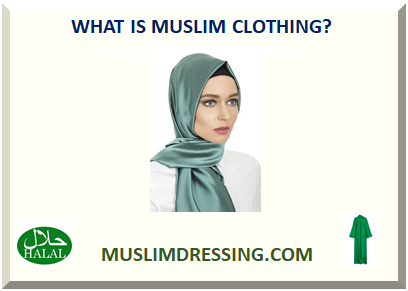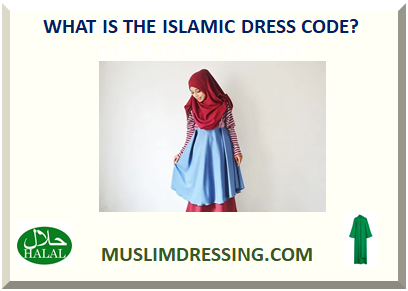ISLAMIC CLOTHING
HALAL CLOTHING MUSLIM DRESSING HALAL CLOTHES DRESS RULES GUIDELINES FOR ISLAMIC DRESS CODE
Islamic clothing in is by definition to attire that is worn by Muslims in adherence to Islamic teachings and customs, also called halal clothing,for both men and women, clothing must cover certain parts of the body (known as "awrah"), be loose-fitting, and not be transparent.
Islamic clothing has the primary purpose to ensure modesty, in the Quran, the holy book of Islam, there are verses that instruct believers, both male and female, to dress in a modest manner, given that modesty in Islam is considered a virtue and a means to safeguard one's dignity and honor in society.
Halal clothing has objectives that extend beyond the physical aspect of covering, first, it serves as an act of obedience to God, as the guidelines are rooted in the Quran and Hadith (teachings of Prophet Muhammad, peace be upon him), second, it promotes a sense of Islamic identity and unity, setting Muslims apart and fostering a sense of community.
Islamic clothing in, it's crucial to note that cultural variations have a significant influence on its practice, for instance, the burqa worn in Afghanistan, the niqab in Saudi Arabia, or the colorful hijabs in Indonesia all cater to the Islamic principle of modesty but are shaped by regional customs and traditions.

How does Islamic fashion differ from regular fashion?
Differences between Islamic Fashion and Regular Fashion:
Islamic Fashion:
- Modesty: One of the primary principles in Islamic fashion is modesty. Clothing designs ensure minimal exposure of the body.
- Coverage: Islamic fashion typically emphasizes covering certain parts of the body. For women, this often means covering everything except the face, hands, and feet in front of non-mahrams (those not closely related).
- Loose Fitting: The clothes are generally designed to be loose-fitting to avoid outlining or emphasizing the shape of the body.
- Transparency: The clothing material should be thick enough so as not to reveal the skin or body silhouette beneath.
- Inspiration: Designs might incorporate Islamic art, calligraphy, or patterns while avoiding images of living beings, following certain interpretations of Islamic teachings.
Regular Fashion:
- Variability: Regular fashion can vary widely based on cultural, societal, and individual preferences, without religious constraints.
- Exposure: Some regular fashion designs may emphasize or focus on revealing certain parts of the body.
- Fitting: Clothes can range from very tight-fitting to loose.
- Trend-Driven: Regular fashion is highly influenced by current trends, celebrity culture, and global events.
- Inspiration: Designs draw inspiration from diverse sources including history, art, movies, nature, and more.

Muslim clothes name: what types of Islamic clothing for women and men, for girl, boy, kids and babies and what is the name of such clothes?
Names of Islamic Clothing by Age Group and Gender:
Islamic Clothing by Age Group and Gender:
Women:
- Hijab: A scarf covering the head and neck but leaving the face clear.
- Niqab: A face covering that leaves the eyes exposed.
- Abaya: A long, flowing dress, often black in color.
- Jilbab: A long coat or cloak.
- Khimar: A cape-like garment that covers the chest and shoulders.
- Chador: A full-body cloak.
- Burqa: A full-body covering that includes a mesh screen over the face.
Men:
- Thobe or Jubba: A long robe worn by men.
- Taqiyah or Kufi: A rounded cap worn by men.
- Bisht: A flowing outer cloak usually worn over the thobe.
- Sirwal or Izaar: Loose trousers that are worn under the thobe.
- Imama or Turban: A head covering, often wrapped around the kufi.
Girls:
- Girl's Hijab: Similar to women's hijab but often smaller and more colorful.
- Girl's Abaya: A flowing dress similar to the women's abaya, designed for younger girls.
Boys:
- Boy's Thobe: A shorter version of the men's thobe designed for boys.
- Boy's Kufi: A rounded cap similar to the men's version.
Kids:
- Generally, kids wear smaller versions of adult clothing, but they might be more colorful or have playful designs.
Babies:
- Babies often wear simple cotton outfits that ensure comfort. There might not be specific Islamic clothing for babies in many cultures, but some families might dress their infants in miniaturized versions of traditional Islamic attire.
ISLAMIC CLOTHING ONLINE